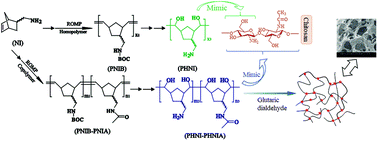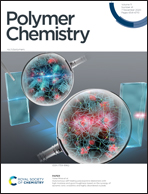Chemical synthesis of chitosan-mimetic polymers via ring-opening metathesis polymerization and their applications in Cu2+ adsorption and catalytic decomposition†
Abstract
Aiming at solving the uncontrollability in the properties of chitosan caused by its uncontrollable structure, we synthesized two chitosan-mimetic polymers, the homopolymer mimic PHNI and the copolymer mimic PHNI-PHNIA, by ring-opening metathesis polymerization (ROMP) and characterized their structures and performances by FTIR, 1H-NMR, 13C-NMR, XRD and DTG. The reaction feature of ROMP demonstrated by size exclusion chromatography (SEC) signifies that the structure and number average molecular weight  of ROMP products can be controlled by tuning the ratio of the monomer to the catalyst, and thus the mimics exhibit structure-controllable and mimicking properties. The relationship between the chemical structure and performance of the mimics is more explicit. The application exploration suggests that the Cu2+ adsorption performance of the PHNI-PHNIA hydrogel prepared with glutaraldehyde as the crosslinking agent is superior to that of the chitosan hydrogel. The catalytic activity of the PHNI-PHNIA-Cu2+ complex for the decomposition of H2O2 is much higher than that of the chitosan-Cu2+ complex. Our work has provided a new strategy for the synthesis of controllable chitosan mimics that can function as a substitute of basic polysaccharides for preparing the derivatives with controllable properties and expand the application scope of chitosan.
of ROMP products can be controlled by tuning the ratio of the monomer to the catalyst, and thus the mimics exhibit structure-controllable and mimicking properties. The relationship between the chemical structure and performance of the mimics is more explicit. The application exploration suggests that the Cu2+ adsorption performance of the PHNI-PHNIA hydrogel prepared with glutaraldehyde as the crosslinking agent is superior to that of the chitosan hydrogel. The catalytic activity of the PHNI-PHNIA-Cu2+ complex for the decomposition of H2O2 is much higher than that of the chitosan-Cu2+ complex. Our work has provided a new strategy for the synthesis of controllable chitosan mimics that can function as a substitute of basic polysaccharides for preparing the derivatives with controllable properties and expand the application scope of chitosan.



 Please wait while we load your content...
Please wait while we load your content...